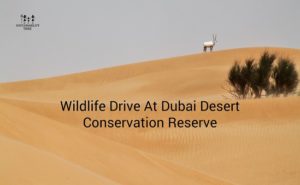
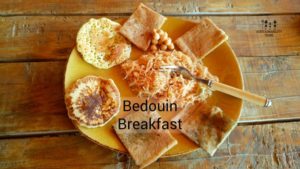 Dubai Desert Conservation Reserve is UAE’s first national park and the largest protected land area in the country spread over 225 square km. I booked my experience with Platinum Heritage through Headout App on my smartphone. It is around 40 minutes drive from Dubai but once we entered DDCR, I felt like we traveled back in time, to historic Dubai, before all the development and before discovering oil in this land!
Dubai Desert Conservation Reserve is UAE’s first national park and the largest protected land area in the country spread over 225 square km. I booked my experience with Platinum Heritage through Headout App on my smartphone. It is around 40 minutes drive from Dubai but once we entered DDCR, I felt like we traveled back in time, to historic Dubai, before all the development and before discovering oil in this land!
 The desert on the Arabian peninsula is the largest sand desert on Earth and is called Rub’ al Khali. The golden sand looked so beautiful in the morning! We first headed to our Bedouin breakfast. The solar-powered Platinum Heritage camp was just like any Bedouin home. Most of the furniture here is made of Ghaf tree timber. After we had Emarati Breakfast, a plate full of Bedouin food; we sat in Majlis to talk to Umm (Uncle) Hamad about Bedouin culture! Umm Hamad is quite a cool guy and answered all our questions with a pinch of humor added to it!
The desert on the Arabian peninsula is the largest sand desert on Earth and is called Rub’ al Khali. The golden sand looked so beautiful in the morning! We first headed to our Bedouin breakfast. The solar-powered Platinum Heritage camp was just like any Bedouin home. Most of the furniture here is made of Ghaf tree timber. After we had Emarati Breakfast, a plate full of Bedouin food; we sat in Majlis to talk to Umm (Uncle) Hamad about Bedouin culture! Umm Hamad is quite a cool guy and answered all our questions with a pinch of humor added to it!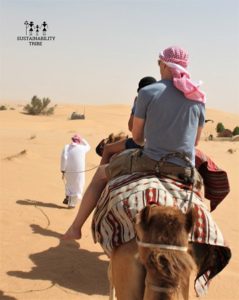
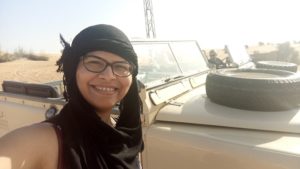
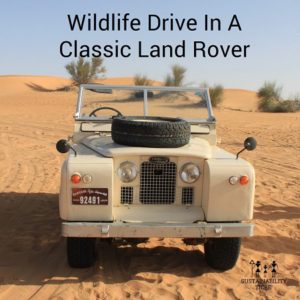 As we started our drive the wind started blowing the sand and we all had to cover our mouths and nose. I have never been to the desert while sand is blowing in the air, but this made our experience even more authentic! It was mesmerizing to see the sand blowing from the top edge of the dunes.
As we started our drive the wind started blowing the sand and we all had to cover our mouths and nose. I have never been to the desert while sand is blowing in the air, but this made our experience even more authentic! It was mesmerizing to see the sand blowing from the top edge of the dunes.First, we searched for mountain gazelles and were lucky to find two herds near the water area. There are water areas where water is refilled for wildlife. It was thrilling to see Gazelles jumping, running in the wild. I personally love these creatures, I find them so graceful! So I couldn’t help taking many photos of these desert beauties. Throughout the drive, we took many stops and our guide Oscar introduced us to many flora and fauna in the desert and fun facts about it.
 |
| Ushar (Top right), Fire Bush (Top Left), Sand Grass (Bottom 2) |
Oscar showed us Sodoms Apple, called Ushar in Arabic. This is an evergreen shrub, it’s beautiful 5 petal flowers are white and dark purple. Milky sap is excreted when any part of the plant is broken. Gazelles eat them to regularize their digestion when they pass hard droppings!
The Firebush, Markh in Arabic Leptadenia pyrotechnica. It has small yellow flowers, these are used in Bedouin food. Its fibers are tough and do not rot in water, so are suitable to be spun into rope. It has been used in carpets since ancient times. Gazelles eat them to regularize their digestion when they pass hard droppings! The animals dig their resting place under the fire bush.
 |
| Ramram (Top right), Rimth, Ghaf Tree |
Next, we stopped to see sand grass or dune grass called as Thenda in Arabic, Cyperus Conglomeratus. This grass the grown at the base of sand dunes. It may look dead or dried, but the roots go deep and the sand near the roots is wet. It comes under the sedge family. Sedges were once used to make sails, ropes, baskets, mats, and also fuel.
As we came near an area covered with numerous shrubs, we got down to check these interesting bushes. Rimth, Haloxylon Salicornicum is an aloe-like fleshy green shrub without leaves. It has many medicinal uses like curing ulcers, but the interesting fact is in the olden day’s ladies used these plants to make eyeliners.
Ramram, Heliotropium Kotschvi has rough branches covered with stiff white hair. Oscar told us traditionally this plant is boiled with meat to get rid of the strong odor.
 |
| Scorpion Burrow, Mushroom, Beetle shell |
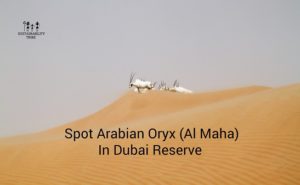
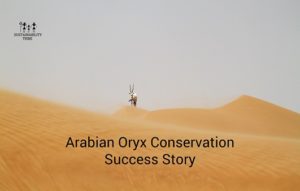
We learned many things about wildlife, their habits, and habitat; biodiversity in the desert. Some of the zones in DDCR are protected only for research, we came across one of them during our drive. I felt like transported to a remote location in this vast empty quarter where there is no trace of urban civilization! I am so glad, I finally decided to visit DDCR, after thinking about it for many years!

When you are going in the desert, don’t forget to get a copy of our UAE Outdoors Scavenger Hunt E-book. This unique ebook will add some fun games to your outdoor trip and will help you get to know UAE’s biodiversity and nature even better.

Amruta Kshemkalyani, an expert sustainability professional turned social entrepreneur, is the founder of the Sustainability Tribe, AK Sustainability
Read More >>
Copyright 2025 © Sustainability Tribe, Registered under 'Sustainability Tribe Marketing Management' in the U.A.E., Design by LBM INFOTECH